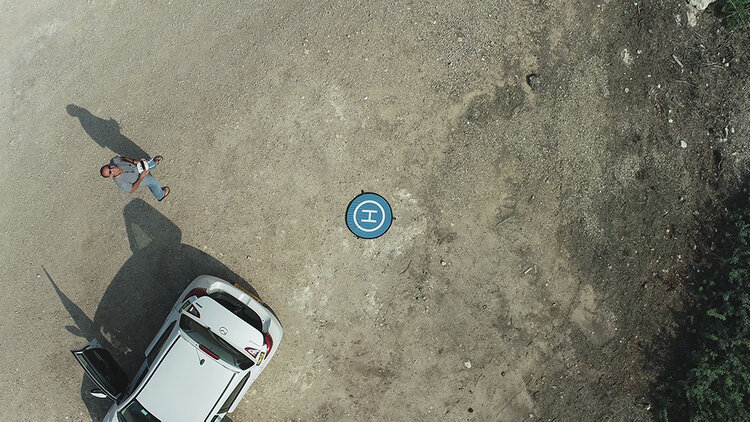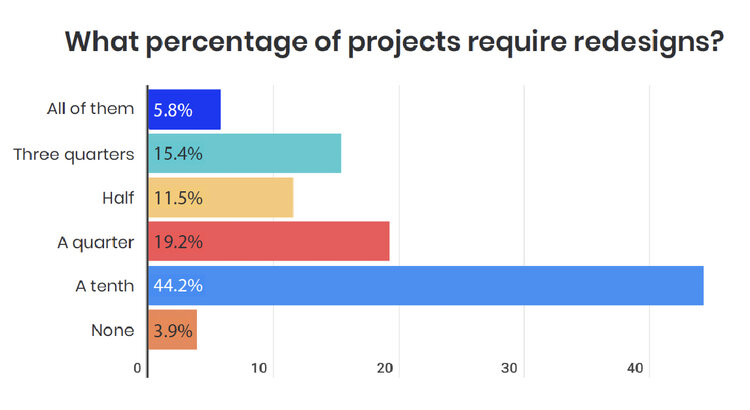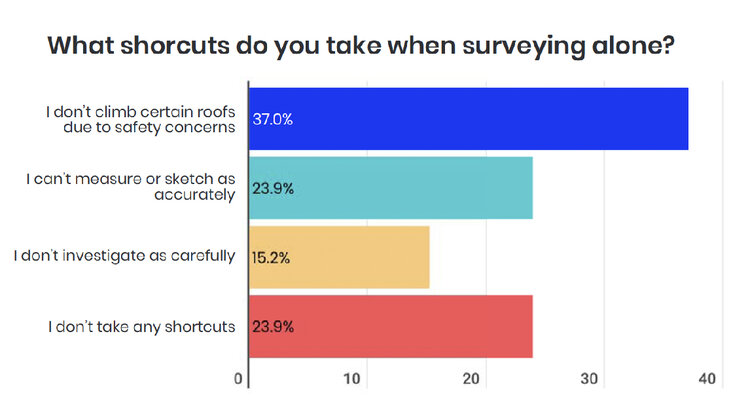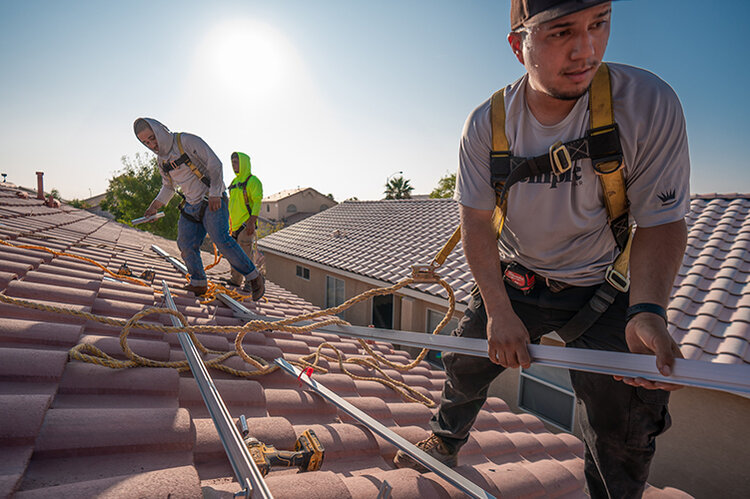Solar site surveyors – also called auditors, techs, or estimators – are essential not just for the project itself, but also for customer experience and even sales. Yet solar contractors increasingly say they can’t find good surveyors. To better understand this challenge, Scanifly spoke to hundreds of solar surveyors about why they feel it’s hard to hire for their role. From there, we asked them what solar companies can do to make the role more appealing to candidates.

Why solar site surveyors matter
Solar site surveyors hold the keys to ensuring a smoothly run process from the beginning. A good surveyor can minimize redesigns, call-offs, and change orders, which happen all too often. Given the cost of labor and truck rolls, even a small redesign can eat away at profits.

Source: Scanifly Solar Surveyor Outlook
A bad surveyor can be disastrous to the entire project, causing delays, giving homeowners incorrect information, or causing damage to the property or injuring themselves. Given the high cost – both financially and from a reputation perspective – of these issues, finding site surveyors you can rely on is key.
Why it’s so tough to find good solar site surveyors
After talking to solar surveyors, here are the top five reasons they gave us why many people might not be interested in survey work.
1. Climbing on roofs is an unsafe chore
The majority of surveyors report either never feeling fully safe (42.5%) or rarely feeling safe (17%) when on a roof. When surveyors feel unsafe, they work quickly to get things done so they can get off the roof. That means taking shortcuts: 15.2% say they don’t investigate the roof as carefully and 23.9% said they don’t measure as accurately. 37% said they won’t even go on certain roofs.

Source: Scanifly Solar Surveyor Outlook
There’s also the environment on the roof. In many climates in the US, temperatures regularly reach over 100F and you can get significant burns being on a roof. In cooler climates, you have hail or precipitation risk for part of the year, making it equally unpleasant and unsafe.
2. There’s a long learning curve
In many cases, being a successful surveyor requires an in-depth knowledge of the electrical system, solar energy, and building structures. Surveyors regularly need to look at every electrical panel, mapping out conduit runs, and helping determine optimal module placement. While most contractors offer checklists or apps to guide surveyors, which include examples, it still requires a lot of technical knowledge that can take years to properly master.

3. You spend a lot of time driving
An average solar site surveyor might spend 45-90 minutes driving between sites. Others drive for 2+ hours to a more rural location or through an urban market with traffic congestion. Even when doing multiple surveys in a single suburb, you’re in and out of your car frequently and the minutes add up. This amount of driving isn’t appealing for many people, making this job – one of the only jobs in solar to require this much driving – less appealing.
4. Upward career mobility appears limited
In many places, the average surveyor earns between $18 to $20 per hour, typically over 40-hour weeks. This turns into an average annual salary of $36,000 to $40,000 per year. While you can earn $3 to $5 more per hour with drone experience, a $50,000 salary is still not enough to live in some urban areas or to support a bigger family.
For many young people, this pay rate will become unsatisfactory in a year or two, and surveyor roles don’t have a clear upward mobility path. Someone can become a head of surveying, manage a team, or even move into design, but that’s company-dependent and could take a few years. Further, upward mobility often requires additional skill development, which many surveyors don’t have the energy given the grueling nature of a surveying job.
5. General anxiety about solar as a new industry
On top of any job-specific issues people might have with a surveyor role, some people are hesitant to move into the solar industry. There has surprisingly been a slight decline in the solar workforce overall according to the Solar Foundation. There’s a lot of opportunity for ambitious people, but the solar sector doesn’t have the same aura of high pay and stable employment that other energy sectors currently enjoy. A lot of the “solar coaster” ups and downs can be tied to local and state-level policy changes.
Four ways to make hiring solar site surveyors easier
Surveyors and would-be surveyors shared their insights about the four things solar contractors can do to make it easier to hire.
1. Integrate drones

Drones make surveying significantly more efficient and much safer. They also democratize who can become a solar site surveyor. With the old, manual method, only relatively young people with fully able bodies can even think about becoming a surveyor. Using a drone as a solar site survey tool, millions more people can become a surveyor even if they can’t physically climb on a roof.
Further, drones give a cool factor to the job that might help attract young people or help people overcome their hesitation about solar, especially those who fly drones as hobbyists. For those who don’t know drones, learning is fairly straightforward and you can get a Part 107 commercial license within a week.

2. Hire former installers
Solar installers have in-depth knowledge of the electrical side of solar projects and are accustomed to the physical demands of the job. This community is a great talent pool that meets all the demands of the solar surveying role, but many solar contractors don’t look to them for surveyor jobs.
3. Increase total compensation
Increasing total compensation is easier said than done. But finding a good surveyor has its own financial benefits: increased surveys completed (especially using drones), higher customer satisfaction, limited redesigns and call-offs, and potentially even more sales. A good surveyor is also more reliable, reducing no-shows and turnover, so you don’t have to hire and train someone every few months.
If you can’t increase the base salary for everyone, consider adding: variable compensation for specific targets like a no-redesign bonus, profit share in the company as a whole, or additional paid time off.
4. Provide career mobility and professional development support

Surveying jobs are fantastic introductions to solar because you see the whole process from end-to-end, but they don’t present that way to many would-be surveyors. If you want to make hiring easier, show the different potential paths that a surveyor could take. Then make sure you explain how you can support a surveyor’s professional development to reach these new heights, including drone training, SEI courses, or NABCEP certifications. If you can’t afford to pay for new credentials for everyone, offer career exposure by creating a job shadowing or rotational program where surveyors can learn more about operations, design, and sales.
Solar needs people and tech to scale
Technology is improving rapidly, which means wonderful things for solar, but humans will always need to be part of the process. Even when we get to the point where drones can fly 100% autonomously (and we’re not far off), you need surveyors for the more delicate roofs, electrical, structural, and for the human interaction portion of the equation. As you think about hiring, make sure you’re aligned on what technology can do versus what humans need to do, then create a system that makes it easy to hire the right people for the job.
Become a Solar Site Surveyor through Scanifly
Scanifly’s Drone Surveyor Associate Program offers surveyors and solar professionals the training they need to become solar site surveyors. By the end of the program, it is expected that participants will obtain their Part 107 remote drone pilot license and fully understand how to utilize and implement drones in a solar contractor’s workflow. Learn more about the program and join our next training.






